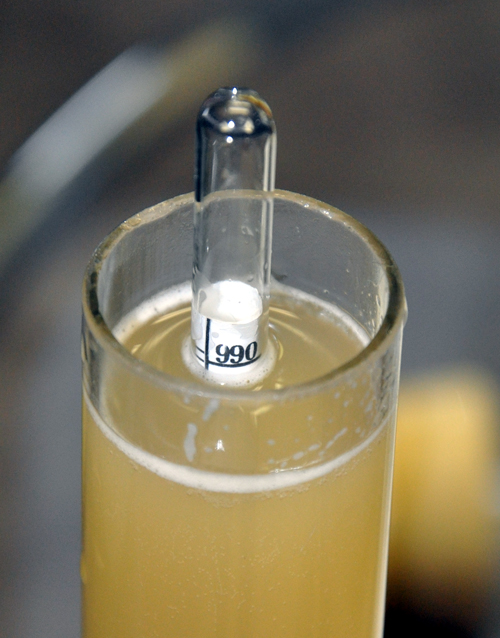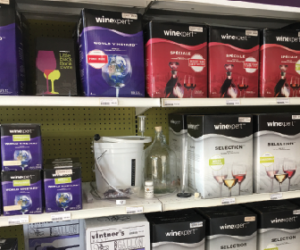
“Sweet!? But this is a dry wine! How can it be sweet? What have I done wrong?” Suddenly, you feel dejected as you try to figure out what possibly could have gone wrong when you made this wine. When a dry wine turns out off-dry or sweet, residual sugar from an incomplete fermentation is the most probable cause. It’s also possible that your friend detects sweetness at lower thresholds than you.
A dry wine should have no perceptible sweetness. A sweet wine — such as a late-harvest type wine or icewine — can have any level of residual sugar. Residual sugar can be either sugars that the yeast did not ferment or sugar that the winemaker added after the wine fermented, or both.
Although it is a matter of taste, the level of sweetness should be appropriate for the type of wine. Off-dry Rieslings or fruity, sweet Muscats, for example, are excellent wines for a summer barbecue or to accompany a dessert, respectively. However, perceptible sweetness found in a Chardonnay or in a Cabernet Sauvignon table wine would be considered a wine fault. The sweetness would off-balance the delicate aromas, flavors and acidity in these wines.
So how do we measure and quantify the amount of residual sugar to avoid making another batch of sweet “dry” wine? Let’s first examine the role of sugar in wines and what exactly contributes to the perception of sweetness.
Understanding Sugar
Sugar is an essential component in the production of wine. During alcoholic fermentation, yeast feeds on the sugar found in grape juice and converts it to ethyl alcohol, or ethanol, and carbon dioxide. The amount of sugar fermented determines the wine’s alcohol level and the amount of residual sugar left in the wine.
Glucose and fructose are the main fermentable sugars in grape juice. Although each type of sugar exists in approximately equal concentrations in wine, fructose is roughly twice as sweet as glucose.
Glucose is also fermented at a faster rate, which means that a wine fermented to dryness will have less residual glucose than fructose. Any glucose and fructose sugars remaining in the wine at the end of fermentation contribute to residual sugar. If two wines have the same residual sugar concentration, the one with more fructose will taste sweeter.
Another source of glucose and fructose is cane sugar, or table sugar, which consists of sucrose. Cane sugar is used to chaptalize, or add sugar to, juice to increase the potential alcohol level of wine. When cane sugar is added, sucrose is naturally inverted by enzymes present in the wine, and “split” into glucose and fructose. Alternatively, winemakers often use corn sugar — or dextrose, which is another name for glucose — because yeast ferments it at a higher rate, and therefore reduces the risk of ending up with a sweet wine. Wine also contains very small concentrations of unfermentable sugars — sugars that yeast cannot convert to alcohol, such as pentose, that contribute to residual sugar.
Clearly, a dry wine always contains a small amount of sugar, which many of us may not perceive. Although sweetness due to residual sugars may not be detected, glycerol — a minor by-product of alcoholic fermentation, also referred to as glycerine — and ethyl alcohol also contribute sweetness, confusing our taste with actual residual sugar content.
Residual Sugar Concentration
Residual sugar concentration is a measure of the amount of sugar solids in a given volume of wine following the end of fermentation and any sugar addition when making a sweet wine. Residual sugar concentration is expressed in grams per liter (g/L) or as a percentage of weight to volume. For example, a wine with 0.2% residual sugar contains two grams of sugar in a liter of wine, or approximately 1/4 ounce in a gallon. Dry wines are typically in the 0.2–0.3 percent range, off-dry wines in the 1.0–5.0 percent range, and sweet dessert wines in the 5.0–15 percent range.
Home winemakers can measure residual sugar concentration through simple methods, most commonly by using a reagent-tablet test kit or a hydrometer. These can only provide approximations, but they are sufficiently accurate for practical purposes, because wines contain many other dissolved solids and compounds (various acids, proteins and color pigments) which will affect measurements.
A word of caution! Any wine measuring greater than -1.0° Brix — or equivalently having a specific gravity greater than 0.995 — when measured with a hydrometer should be stabilized with potassium sorbate to prevent bottle fermentation. If wine starts refermenting in the bottle, the bottle may explode. If you are making an off-dry or sweet wine, add sorbate at the rate of 10 g/hL (approximately one teaspoon per 20-liter or five-gallon batch) to wine in which sulfite has been added to a concentration of 25–50 mg/L.
Do not add potassium sorbate to wines that have undergone malolactic fermentation. Potassium sorbate reacts negatively with lactic bacteria and results in a geranium-like off-odor. The alternative is to stabilize the malolactic-fermented wine with sulfite followed by a fine filtration, then monitor the wine during bulk aging to ensure that fermentation does not restart.
The most common and simple method to measure residual sugar concentration is by using Clinitest® reagent tablets. This method complements the hydrometer when trying to assess the dryness in wines. The hydrometer cannot be used for quantitative residual sugar determination, but can provide an indication if too much sugar is still present.
Clinitest® Method
Clinitest® reagent tablets are commonly used by diabetics for glucose analysis in urine. Testing the amount of glucose in urine is an indirect way to monitor blood sugar levels. It’s not a product that one would associate with wine analysis; however, these reagent tablets provide a simple and quick method for determining approximate residual sugar content in wines. Some home winemaking supply shops carry this product, or it can be purchased at drugstores. Clinitest® tablets are available as part of a kit (under $30 US) containing 36 tablets and an eyedropper and vial to perform the test, or 36, 50 or 100-tablet bottles can be purchased separately.
One reagent tablet is used to measure residual sugar concentrations up to five percent. The result is approximate but is quite acceptable for home winemaking purposes. The test is less accurate for red wines because phenolic compounds, including tannins and color pigments, interfere with the test.
Similarly, ascorbic acid — used as an anti-oxidant — also affects the test. Also, sucrose will not be detected by this test if performed immediately after chaptalization. This is because the sucrose has not yet been inverted by the yeast into glucose and fructose. The effect of chaptalization before or during fermentation is best measured using a hydrometer.
The Clinitest® method is based on a chemical reaction called copper reduction. Tablets contain copper sulfate, which reacts with sugars present in wine. The resulting color change, which varies with the amount of sugar present, is compared to a color chart provided with the tablets to determine the residual sugar content.
Using an eyedropper, put 10 drops of the wine sample in a small test tube and then drop in one tablet. The tablet and wine sample will cause a “boiling” reaction and color change. Carefully observe the color change during the reaction, making sure not to shake the test tube during this time or for 15 seconds after the boiling effect has stopped.
If the color changes rapidly from bright orange to a dark or greenish brown, then the wine sample contains more than one percent residual sugar and a second test with a diluted wine sample is required. Otherwise, after the 15-second waiting period, gently shake the test tube and compare the color of the sample to the color chart to determine the corresponding sugar concentration measurement.
For wine with one to five percent residual sugar, a two-drop wine sample should be diluted with eight drops of water. Then perform the test as directed above. The color should be compared to the two-drop method color chart, and the result is then multiplied by five to determine the residual sugar concentration. For example, if the color change indicates 0.4 percent sugar, then the actual measurement is two percent residual sugar.
Be sure to read and observe all the of the documented safety precautions when handling this product. It is highly corrosive. Read the instructions carefully to avoid any problems.
Hydrometer Method
The hydrometer we all use when measuring Brix or specific gravity (SG) is a practical instrument to monitor the rate of fermentation. It provides a good indication of when fermentation is complete in dry wines, usually when the reading is -1.0° Brix (SG 0.995) or less. This is not a measurement of residual sugar concentration, but rather an indication of the possibility that sugar is still present. At this low range, the hydrometer only provides a rough approximation of sugar content. The measurement is affected by the presence of other solids in the wine sample, as well as alcohol and carbon dioxide. With little sugar in the wine, dissolved solids other than sugar play a larger role in determining how high the hydrometer floats compared to times when sugar is more abundant (for example, prior to fermentation).
The best advice then is to take a hydrometer reading, and if you suspect residual sugar either from tasting the wine sample or from a higher than normal hydrometer reading, perform a Clinitest® measurement. I recommend running a Clinitest® assay anytime the hydrometer reading is above -1.0° Brix (SG above 0.995).
To minimize error when using a hydrometer, reduce the amount of solids in the wine by passing the sample though through a paper filter, such as a coffee filter. Pour the sample in the cylindrical tube with the hydrometer already inside. The sample should reach close to the top of the tube. Give the hydrometer a couple of fast spins to eliminate as much carbon dioxide gas as possible, then take a hydrometer reading at eye level.
The sample should be measured at the temperature indicated on your hydrometer. Hydrometers are calibrated for measurements at a specific temperature, typically at 60° F (15.5° C). Use a small wine thermometer to determine the temperature of the sample. If the temperature is too high, cool the sample by placing the container in a fridge or a cold-water bath. If it is too low, apply some heat or place the container in a hot-water bath.
A narrow-range hydrometer with smaller graduations can also be used to improve accuracy of measurements. For example, you can buy a hydrometer with a range of negative five to positive five Brix with 0.1° graduations for less than $15 US.
Other Methods
Other laboratory methods for determining residual sugar concentration are available; the Rebelein method is probably the most popular and widely used in commercial wine analysis. These advanced methods provide more accurate results and can measure higher concentrations of residual sugar; however, they require the use of chemicals not readily available to home winemakers. The required chemicals can be found at chemical supply shops or research laboratories.
In the Rebelein method, a laboratory process — termed copper-ion reduction — is used to determine residual sugar concentration. A wine sample is mixed with a copper sulfate solution and an alkali salt solution made from sodium potassium tartrate and sodium hydroxide. After a rapid boil, potassium iodide and sulfuric acid solutions are added to the mixture and it is then titrated with sodium thiosulfate. The residual sugar concentration is determined by the amount of titrate used in titrating the wine sample compared to titrating a water sample.
For more information on these methods, consult any advanced wine analysis textbook. “Winery Technology & Operations: A Handbook for Small Wineries” by Dr. Yair Margalit (The Wine Appreciation Guild) and “Wine Analysis And Production” by B. Zoecklein, K. Fugelsang, B. Gump and F. Nury (Aspen Publishers) are good references.



